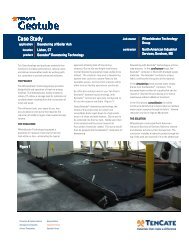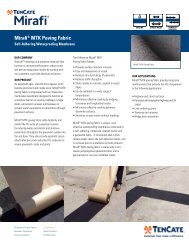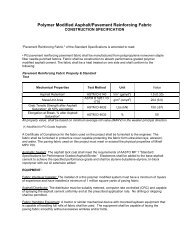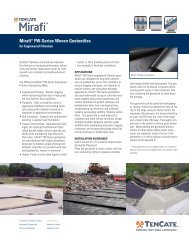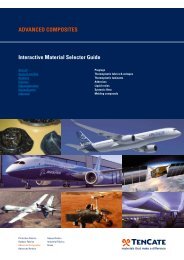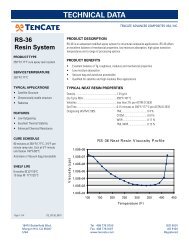download as .pdf - TenCate
download as .pdf - TenCate
download as .pdf - TenCate
- TAGS
- download
- tencate
- tencate.com
Create successful ePaper yourself
Turn your PDF publications into a flip-book with our unique Google optimized e-Paper software.
Sustainability / Environment<br />
TenCaTe pLaYer in rapiDLY growing markeT<br />
incre<strong>as</strong>ing use of composites and improvements in<br />
production processes.<br />
Across the world some 550,000 people earn their<br />
living in the composites industry.<br />
These figures were provided by JEC Composites,<br />
which h<strong>as</strong> extensively charted the ‘rich and<br />
complex’ world of composites. JEC (Journals,<br />
Exhibitions & Composites) h<strong>as</strong> set itself the t<strong>as</strong>k of<br />
promoting composite materials worldwide. JEC’s<br />
global network connects more than 250,000 people<br />
who are professionally involved in composites.<br />
The composites industry is highly innovative. This<br />
innovative attitude is also essential, <strong>as</strong> the<br />
composites industry faces a number of challenging<br />
t<strong>as</strong>ks, including automation (making production<br />
processes f<strong>as</strong>ter and cheaper through for example<br />
robotization) and the development of new raw<br />
materials, resins, and gl<strong>as</strong>s and carbon fibres. ‘Each<br />
link in the value chain h<strong>as</strong> a contribution to make to<br />
this’, Frédérique Mutel (Chairman and EO of JEC<br />
Composites) told us. ‘This makes all the players in<br />
the value chain mutually dependent.’<br />
innovations<br />
The demand for carbon fibre will incre<strong>as</strong>e between<br />
2009 and 2012. Aerospace and industrial<br />
applications are showing the strongest growth.<br />
The innovation of resins and additives involves for<br />
example low-emission resins, bio-resins, improved<br />
18 txtures | number 4 | winter<br />
prepregs and carbon and gl<strong>as</strong>s fibres with greater<br />
strength. When it comes to process innovation, the<br />
terms simulation and prototyping are often heard.<br />
‘Computers allow you to simulate anything. You can<br />
design a product on a computer; you don’t need to<br />
build a scale model to do it. After rapid prototyping<br />
you can immediately start on serial production.<br />
Also, you can simulate the ageing process of<br />
composites.’<br />
Apart from the focus on new raw materials and<br />
materials, attention is also given to obsolete<br />
products: recycling. Who does the collecting, who,<br />
the removal and who, the recycling? As far <strong>as</strong><br />
regulations are concerned, Japan and the EU are to<br />
date the most progressive in this process. EU<br />
legislation for the recycling of cars and electrical<br />
equipment provides opportunities for the<br />
composites industry. In the US regulations relating<br />
to materials, chemicals and recycling are<br />
continually improving. ‘Recycling is a great<br />
challenge for the industry and will become ever<br />
more important.’<br />
Collective<br />
One of the specific qualities of the composites<br />
industry is its collective knowledge. ‘The market<br />
wants products that don’t rust and require little or<br />
no maintenance. Companies in the value chain are<br />
constantly working together to find the best<br />
solution.’ There is also internal competition within<br />
the sector: between thermosets and<br />
thermopl<strong>as</strong>tics for example, where<strong>as</strong> the real<br />
competition is taking place outside, in other<br />
materials. She feels that not all the companies can<br />
see the big picture. ‘JEC Composites plays an<br />
important role in this by uniting all the families,<br />
representing the sector and coming up with various<br />
solutions. The collective challenge is to expand the<br />
composites markets and you can’t do that with<br />
forty different families and poor arguments and<br />
resources.’<br />
Following on from that, JEC Composites wants to<br />
incre<strong>as</strong>e the visibility of composites and<br />
communications about them. ‘There are too many<br />
expressions for the same sorts of materials. All the<br />
links in the value chain talk about composites, and<br />
<strong>as</strong> a result there are too many confusing terms. The<br />
industry is relatively young so we must present<br />
ourselves far more clearly and, with the backing of<br />
a strong industry, show end-users and markets<br />
what you can do with composites and be efficient<br />
in conveying their advantages.’




